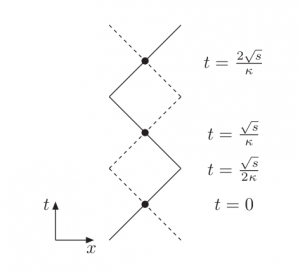Lund string model
The Lund String model is a model for hadronisation, i.e. the process of transforming a partonic final state to a hadronic one.
The model is built upon a "string" analogy, a potential linearly rising with the distance between the two quarks. At some point, the potential energy stored in the string is so large, that the string will break into hadrons. The Lund model includes the possibility for creation of hadrons with light quark content (u, d and s-type), mesons as well as baryons.
The yo-yo model for mesons
The Lund string model is built up around a string model for mesons, where mesons are described as two massless quarks moving in 1+1 dimensions, connected by a massless string, making the quarks turn around when the string is maximally extended. This type of movement pattern (called directrix) is called the yo-yo because of its resemblance to the toy. (See ref. [1] for a through discussion of several directrices)
